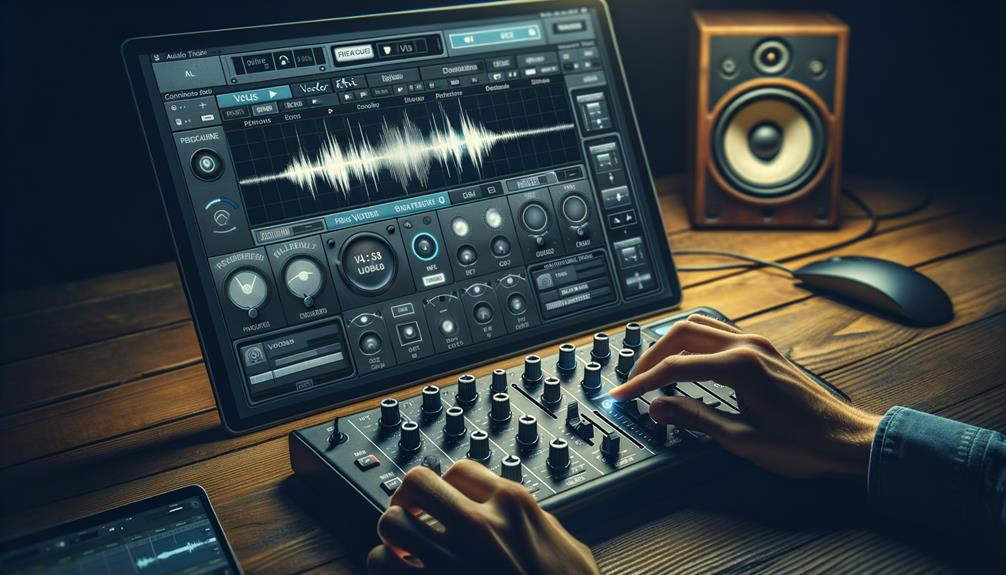No products in the cart.
If you want to elevate your music production with unique vocal effects, using Ableton Vocoder is the way to go.
By understanding the different controls and settings, you can customize the Vocoder’s sound to your liking.
The ‘Enhance’ button, ‘Unvoiced’ control, ‘Sensitivity’ control, and ‘Detection Speed’ setting allow for fine-tuning and balancing of the sound.
But there’s more to it than just tweaking these parameters.
As you explore this powerful tool, you’ll discover how to seamlessly integrate it into your music and create captivating vocal textures.
Contents
hide
Key Takeaways
- Set up the Vocoder in Ableton by configuring audio inputs and outputs and creating separate audio and MIDI tracks.
- Adjust the Vocoder’s parameters such as the ‘Release’, ‘Attack’, ‘Enhance’, ‘Unvoiced’, ‘Sensitivity’, and ‘Detection Speed’ to control the Vocoder’s response and sound.
- Experiment with different carrier and modulator sources, including using a harmonically rich synthesizer sound and your own voice, to create unique vocoder effects.
- Fine-tune the Vocoder effects by balancing frequency bands, enhancing intelligibility, modifying the number of bands and bandwidth, exploring different filter voicings, and adding depth with the noise oscillator.
Setting Up the Vocoder in Ableton
To set up the Vocoder in Ableton, follow these steps:
- Ensure that you have the necessary audio inputs and outputs configured in your audio preferences.
- Create a new audio track and set its ‘Audio From’ input to the source you want to use as the modulator signal. This could be a vocal track, a synthesizer, or any other sound source.
- Create a separate MIDI track and set its output to the Vocoder’s carrier signal.
- In the Vocoder effect plugin, set the ‘Modulator’ chooser to the audio track with the modulator signal.
- Adjust the ‘Release’ and ‘Attack’ parameters to control how quickly the Vocoder responds to changes in the modulator signal.
- Experiment with the ‘Bandpass Filters’ to sculpt the sound and create different tonal qualities.
- Consider adjusting the ‘Depth’ parameter to control the intensity of the effect.
- Finally, ensure that the Vocoder is enabled and tweak the settings to achieve the desired vocoder effect.
Understanding Vocoder Parameters and Controls
Understanding Vocoder Parameters and Controls involves mastering the various settings and controls that shape the vocoder’s sound to achieve the desired effect. To fine-tune the Vocoder and create an innovative sound, pay attention to the following specific notes:
- The ‘Enhance’ button: This control normalizes the frequency bands, balancing the sound and ensuring a consistent output. Adjust this setting to optimize the clarity and presence of the carrier signal.
- The ‘Unvoiced’ control: Adding noise to improve the intelligibility of specific syllables, this control allows for precise adjustments to enhance the overall quality of the sound. Use this control to refine the balance between the carrier signal and the added noise, ensuring a dynamic and engaging result.
The ‘Sensitivity’ control determines the amplitude threshold for triggering the noise and the ‘Detection Speed’ setting adjusts the reaction speed of the Vocoder, both of which play crucial roles in shaping the way the vocoder works.
Applying Vocoder to Vocals in Ableton

Explore the versatile applications of Ableton’s Vocoder, particularly in enhancing vocals for a dynamic and innovative sound.
When applying the Vocoder to vocals in Ableton, it’s essential to understand its functionality. Select a carrier signal, typically a harmonically rich synthesizer sound, to modulate the frequency content of the input signal. Adjust the Vocoder controls such as ‘Enhance’, ‘Unvoiced’, ‘Sensitivity’, and ‘Detection Speed’ to fine-tune the sound and achieve the desired effect.
Additionally, delve into the band settings to modify the number of bands and adjust the bandwidth, providing precise control over the Vocoder’s output. This manipulation allows you to tailor the Vocoder’s effect to suit the specific characteristics of the vocals.
Utilize the ‘Precise’ and ‘Retro’ modes to experiment with different voicings and enhance the desired sound of the Vocoder. By understanding these features and controls, you can actually mold and shape the frequency bands to create a unique and innovative vocal sound that stands out in your music production.
Experimenting With Vocoder Carrier and Modulator Sources
Consider utilizing a harmonically rich synthesizer sound as the carrier signal for traditional setup. This will provide a strong and complex foundation for the vocoder effect, adding depth and texture to the modulated sound.
Additionally, experiment with using your voice as the modulator signal to achieve different vocal effects. This can range from subtle harmonies to robotic or alien-like transformations, depending on the modulation settings and parameters used.
When experimenting with vocoder carrier and modulator sources, explore combining different audio sources to create unique and diverse vocoder sounds. This could involve using non-traditional sources such as drum loops or instrument recordings as carrier and modulator signals.
Adjust the levels and frequencies of the carrier and modulator sources to achieve the desired vocoder effect. This allows for fine-tuning and customization, enabling you to create a wide range of sounds and effects with the Ableton vocoder.
Experimenting with vocoder carrier and modulator sources opens up a world of creative possibilities, allowing you to push the boundaries of traditional vocoder applications.
Tips for Fine-Tuning Vocoder Effects


When fine-tuning the vocoder effects, it’s essential to carefully adjust the ‘Enhance’ button to balance frequency bands and improve the overall sound, ensuring a well-defined and impactful output. The ‘Enhance’ button is a powerful tool that allows you to shape the sound of the vocoder by boosting specific frequency bands. By fine-tuning this control, you can enhance the clarity and definition of the modulated signal, resulting in a more pronounced and articulate vocoder effect.
Below is a table summarizing key tips for fine-tuning vocoder effects:
| Tips for Fine-Tuning Vocoder Effects |
|---|
| Adjust the ‘Enhance’ button to balance frequency bands and improve overall sound. |
| Experiment with the ‘Sensitivity’ control to enhance intelligibility by setting the amplitude threshold for triggering noise. |
| Modify the number of bands and adjust the bandwidth in the ‘Bands’ section to shape the Vocoder’s output. |
| Explore the ‘Precise’ and ‘Retro’ modes to achieve different filter voicings and character for the Vocoder. |
When fine-tuning the vocoder effects, take a look at the noise oscillator to add depth and texture to the modulator signal. By adjusting the noise oscillator, you can introduce subtle nuances and harmonics to the vocoder effect, enriching the overall sonic character.
Frequently Asked Questions
How Do I Set up Vocoder in Ableton?
To set up Ableton’s Vocoder, drop it into the vocal track and select a carrier signal. Adjust Vocoder controls like ‘Enhance’, ‘Unvoiced’, ‘Sensitivity’, and ‘Detection Speed’. Explore band settings for precise control. Utilize Precise and Retro modes for different voicings.
What Do I Need to Use a Vocoder?
You’ll need a microphone for the modulator signal, a carrier signal from a synthesizer, and a DAW with a Vocoder effect, like Ableton Live. Familiarize yourself with audio routing and signal processing for optimal Vocoder settings.
How Do I Get a Good Vocoder Sound?
To get a good vocoder sound, focus on vocal modulation, synth integration, and sound manipulation. Experiment with carrier and modulator signals, adjust band settings, and explore different modes and effects to achieve unique and creative results.
How Do You Make Vocals Sound Robotic in Ableton?
To make vocals sound robotic in Ableton, manipulate the vocals using the Vocoder. Apply creative effects and vocal processing to achieve a futuristic, electronic sound. Experiment with sound design and vocal synthesis for innovative results.
Conclusion
Now that you have mastered the controls and settings of Ableton’s Vocoder, you can confidently apply it to your vocals and experiment with different carrier and modulator sources.
Use the ‘Enhance’ button, ‘Unvoiced’ control, ‘Sensitivity’ control, and ‘Detection Speed’ setting to fine-tune the sound, and explore the ‘Bands’ section for further control over tone and clarity.
With these advanced techniques, you can create unique and customized vocal effects in your music production.




